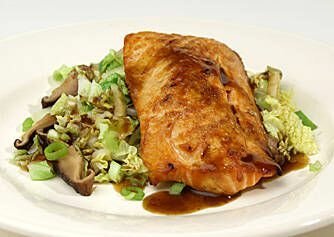healthy food tip and recipe
Today's Recipe
If you don't know what to serve for dinner tonight ...
The balanced flavor in this Asian flavored dish with Chinese 5 spice (a combination of star anise), cloves, cinnamon, huajiao (Sichuan pepper) and ground fennel seeds) is wonderful. This is a surprising dish that is both light, yet very flavorful. It is full of nutrition, and very easy to prepare.

Ingredients:
- 1 lb salmon filet cut into 4 pieces
- 6 dried medium shiitake mushrooms soaked in 3/4 cup hot water for about 15 minutes (save water)
- 1 medium sized onion, chopped
- 2 cloves garlic, chopped
- 1 TBS fresh ginger, chopped, or 1/3 tsp dried
- 1 cup vegetable stock
- 1 tsp 5 spice powder (can be found in Asian section in supermarket)
- 3/4 cup fresh orange juice
- 2 TBS molasses
- 2 tsp arrowroot
- 4 cups shredded Chinese, or Napa cabbage
- 6 scallion, chopped
- salt and white pepper to taste
- Soak shiitake mushrooms in 3/4 cup hot water. Slice when soft cutting out stem. Preheat broiler on high.
- Healthy Sauté onion in medium saucepan over medium low heat for about 5 minutes stirring frequently. Add ginger and garlic and continue to sauté for another minute. Add vegetable stock, 5 spice powder, orange juice, and molasses. Simmer for 15 minutes. Strain and discard all but liquid. Place liquid back into pan, and thicken with arrowroot dissolved in a little water while simmering.
- While sauce is cooking, simmer in another medium sized sauté pan cabbage, mushrooms, scallion, salt and pepper in mushroom water for 5 minutes.
- Rub salmon with salt and pepper. (You can Quick Broil with the skin on; it just takes a minute or two longer. The skin will peel right off after cooking.)
- When pan is hot, use a hot pad to pull out the pan from the heat and place salmon on it, skin side down. Return to broiler. Keep in mind that it is cooking rapidly on both sides so it will be done very quickly (usually about 7 minutes for every inch of thickness.
- Cucumber, Seaweed Salad
In-Depth Nutritional Profile for 5 Spice Salmon
Healthy Food Tip
Is it safe to eat raw eggs?
While I realize that some websites disagree with me on this
issue, I believe that it is not safe to eat raw eggs. The main issue
regarding eating raw eggs is contamination with the Salmonella bacterium
with the secondary issue involving the availability of the B-vitamin,
biotin.
According to the U.S. Department of Agriculture, Salmonella contamination may be a problem with about 1 in every 30,000 eggs. Now, just because an egg contains Salmonella bacteria does not mean that you will get a Salmonella infection and eggs are not the only way that Salmonella infections can spread-so you might get a Salmonella infection even if you never eat a raw egg.
However, from my perspective, even a very small risk is not worth taking in this situation -and there is no way to avoid taking a very small risk when you eat a raw egg. Since bacteria enter the ovaries of healthy looking hens even before the shells are formed, you cannot tell from looking at eggs whether they are contaminated. This is why I feel it's important to properly handle and cook eggs to eliminate the risk of Salmonella infection.
Here are some steps you can take to help do so:
• Be sure to purchase eggs from a refrigerated case and place them in your refrigerator as soon as you get home. It is best to use eggs within three to four weeks of purchase.
• Cooking eggs destroys the Salmonella; however, they must be cooked to a temperature of at least 160°F (71°C). Sunny-side up and over-easy eggs often do not reach this temperature.
• Refrigerate hard-boiled eggs two hours after cooking.
• Refrigerate all foods that contain eggs.
• For recipes that contain raw eggs such as Caesar salads, mousse, or homemade ice cream, it is best to use pasteurized eggs that have been heated to a high enough temperature to ensure that the Salmonella has been destroyed.
A second issue involved with raw eggs is the availability of biotin. Biotin is an important B-complex vitamin that's found in both the whites and the yolks of raw eggs. Not all of this biotin is available to our body when a raw egg is eaten, however, because there is a protein found in raw egg whites- called avidin-that binds together with biotin and prevents it from being absorbed from our digestive tracts.
The best way to prevent this lowering of biotin availability is to cook the egg whites. The cooking of an egg will destroy the binding power of avidin so that the biotin in the egg will become more available. While you could separate the yolk from the white and cook the white only to achieve this same result, the risk of Salmonella infection from the raw egg yolk would remain. So from my perspective, this second issue involving biotin is just one more reason to stick with cooked versus raw eggs.
As with all foods, I recommend purchasing organically grown eggs whenever possible-not for the sake of avoiding Salmonella, but for the sake of avoiding unwanted toxic residues that make their way into the egg after the chicken has consumed food or water containing these unwanted substances.

No comments:
Post a Comment